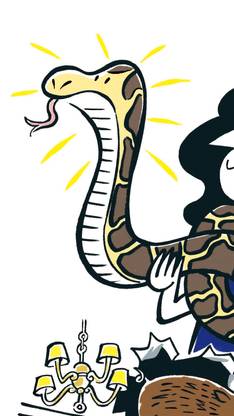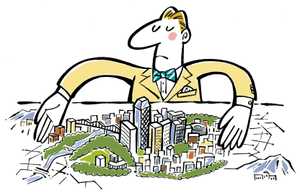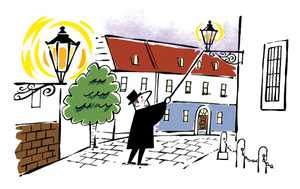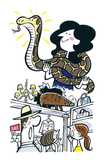Try running this / Global
Take the lead
Every city needs a leader – a reliable ruler to rally troops and respond to demands – but when his or her duties include diving into murky sewers, catching venomous snakes or working through the night, it can be tricky to find a taker. Here are five figures who aren’t afraid of a little – or a lot of – hard work.

01.
Snakes and ladders
Hong Kong
Visit Hong Kong and you’re more likely to be concerned with the height of the buildings than the creatures that crawl the streets. But alongside the city’s seven million residents live over 50 species of snake, including deadly cobras and vipers.
When a 3-metre Burmese python is found in the city’s quiet Sai Kung neighbourhood with a small goat inside it, for example, snake catchers are called in by the police. Today the only female catcher is Chau Ka Ling, who has been in business since 1971, helping to remove the city’s most dangerous fauna. “All I need is a pair of gloves, a hook, some venom and a bag,” says Chau, whose family restaurant, that serves snake, is where some of her catches end up. “Over 80 per cent of the time I catch snakes for the police but sometimes I get calls from private clients.”
Mostly found on Hong Kong’s outer islands or in the country parks, the snakes pose more of a threat to pets and farm animals than to humans. Nevertheless, when cornered they can make even Chau feel nervous. “The most annoying thing is when a snake is in a small hole in someone’s house. The homeowner may have scared it so I have to work out where it might have gone. It’s a game of hide and seek.”

02.
Taking a nosedive
Mexico City
As a teenager, Julio César Cu dreamed of becoming a professional diver. Eventually his wish came true but his fantasy of diving in the turquoise waters of the Caribbean didn’t quite work out: instead he explores the subterranean bowels of Mexico City.
Cu is the only sewer diver in a capital city of 21 million. For the past 33 years it has been his job to free the sewers and water pumps of blockages and to ensure that wastewater – 12,000 tonnes of it a day – keeps flowing. “People say I’m crazy but I love my job. You never know what you’ll find down there; it’s exciting,” says the 55-year-old. “If I unclog a water pump it means it doesn’t break or shut down, which would require two weeks of repair. We get the job done in a day.”
Using a crane, Cu is submerged into fetid waters up to 45 metres deep looking for rubbish. Over the decades he’s brought to the surface bicycles, fridges, carcasses and carpets, as well as “a dozen or so” corpses. “The water is pitch black. I’m blind down there. I feel my way through the black waters. I find things and feel blockages through touch,” he says.
During the rainy season Cu braces himself for hard work, diving for up to four hours a day in the murky depths. Thanks to Mexico City’s rising population the antiquated sewage system struggles to cope with ever more waste from humans, factories and hospitals and is prone to flooding in a deluge. “More water flowing brings more rubbish flowing,” says Cu.
The deeper he dives, the more vulnerable he becomes. To protect himself Cu wears an airtight Norwegian diving suit. “The biggest danger is for my suit to get cut with glass or a syringe and be exposed to the contaminated water. And to lose communication with the team above.”
As Mexico City’s population continues to grow, so does demand for drinking water and space to deal with wastewater. To tackle the issue, the capital began building a new 60km-long drainage system in 2008, which has yet to be fully completed. Billed as the world’s longest wastewater tunnel, the city hopes that it will improve the water supply and sanitation for millions.
But Cu isn’t worried that these tunnels will put him out of a job: “There are many years left of this yet.”

03.
Far from the maddening crowd
Calgary
Calgary has a problem many cities would love to have to deal with: it’s too popular. Almost 40,000 new residents arrive every year, many drawn by the city’s energy industry, and this has led to rents skyrocketing and the population spilling further into the outskirts.
The task of keeping the inner city a pleasant and affordable place to live rests on the shoulders of chief planner Rollin Stanley, a 57-year-old Canadian who has spent a decade managing suburban sprawl. “We need higher and smarter density. Suburbia isn’t necessarily a problem but it has to be dealt with in an efficient and sustainable manner.”
Since starting his job in 2012, Stanley has adopted a multi-pronged strategy. He revamped Calgary’s zoning system and started requiring developers to incorporate civic-conscious elements into their designs. Bike lanes have been added and pedestrian infrastructure spruced up so Calgarians rely less on cars, which eases traffic congestion. Meanwhile, on the legislative side, he meets with councillors every day to work out rental regulations that make leasing secondary suites easier for landlords and safer for tenants.
Perhaps the most ambitious of his current undertakings is a citywide study to guide the development of communities across Calgary. “We have to be comprehensive to preempt needs and tackle all of them at once,” he says.

04.
Guiding light
Wroclaw, Poland
The sky is still a pale blue when Robert Molendo parks his car behind Wroclaw’s cathedral and dons a black cloak and brimmed hat. “Here comes Zorro,” he says as he embarks on his daily walk lighting the 103 gas street-lights on Wroclaw’s historical Cathedral Island by the river Oder.
Molendo’s working hours shift with the sun (he alternates days with a colleague and there’s a third employee as back-up). In June he starts at 20.30, in December at 15.30. When he began the job over seven years ago it took him a week to get the hang of the 2.5-metre rod that he uses to lift the gas valve on each lamp. “It’s like a giant lighter,” he says. The soft sound it makes, similar to a lit gas hob, follows him as he criss-crosses the cobbled streets between lampposts. “This one’s offended,” he says, when one refuses to light at first attempt.
The lamps, replicas of 19th-century originals melted down in the postwar decades, are managed by Gaz-Technik, a firm that won the city tender. They are no cheap alternative to electricity: they need to be cleaned, checked for gas leaks and have damaged parts exchanged. The whole operation costs over PLN290,000 (€70,000) a year according to Wroclaw’s Road and City Maintenance Office, which oversees them.
“These may not be the brightest streets in Wroclaw but they have their own unrepeatable charm,” says Molendo, pointing to the lights’ “fairytale” glow, which stirs up fond memories among elderly passers-by. “It’s an oasis of calm here,” he adds, nodding towards the Botanical Garden next door. Children rush up, craning their necks, and Molendo duly poses for a photo with them. Then, an hour after he began his walk, his work is done; at least until 03.00, when he has to put them out one by one.

05.
Traffic-jam sessions
Kuala Lumpur
Diesel-belching buses and lorries, endless streams of motorcyclists and unpredictable motorists; it takes a brave soul to venture onto the traffic-clogged streets of Kuala Lumpur. Brave souls such as 36-year-old graphic designer Jeffrey Lim, who cycles regularly around the Malaysian capital and spent two years mapping its routes.
While the Bicycle Map Project was Lim’s vision, other cyclists helped him sketch out the paths. “It kept me up at night, the risk of volunteers getting injured,” he says. Luckily they all emerged unscathed and apart from the occasional collision with vehicles in the congestion, Lim has also avoided serious injury: quite a feat in a city where four million cars converge every day.
Now the authorities are finally taking notice. The first of five suburb-to-city cycling corridors proposed by Lim opened in April. A 2km route around the centre is also going ahead and cycle paths are key to the clean-up project for the city’s rivers. “We can’t be Copenhagen overnight,” Lim says. “The three big issues are safety, the weather and crime. These questions have to be answered.”
Still, as officials push ahead with plans to make KL an easier place for its residents to live (a mass-transit system is finally under construction), the idea of getting about by bicycle is no longer quite as far-fetched as it might once have seemed.
“When I first came back to KL I would see maybe one or two people a day; now I see five to 10. These are the fearless cyclists, people who are conditioned to the traffic. They are a special breed.”


